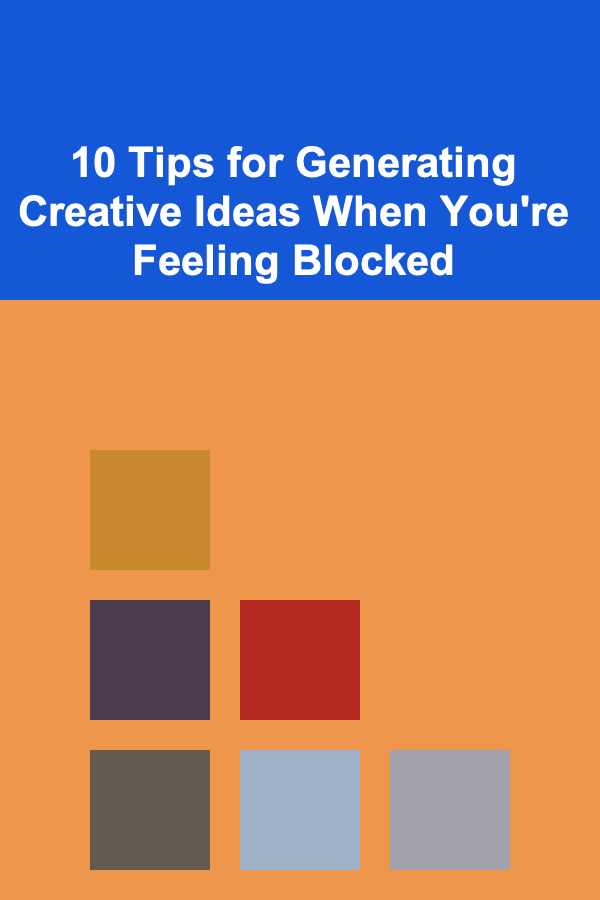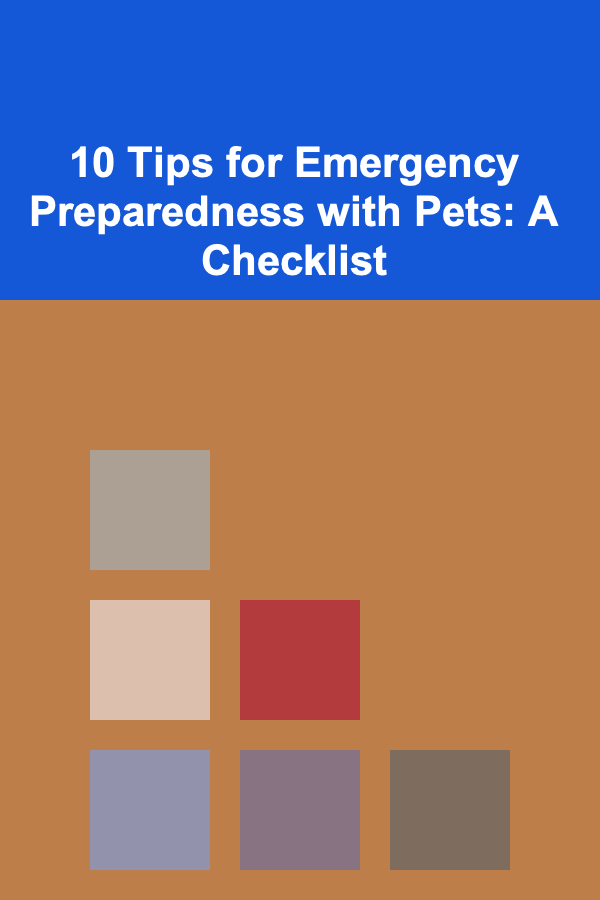
10 Tips for Generating Creative Ideas When You're Feeling Blocked
ebook include PDF & Audio bundle (Micro Guide)
$12.99$8.99
Limited Time Offer! Order within the next:

Creativity is a powerful tool that drives innovation, problem-solving, and artistic expression. However, even the most creative minds face moments of blockage, where generating new ideas feels impossible. Whether you're working on a writing project, brainstorming for a business, or pursuing a personal passion, creative blocks are an inevitable part of the process. Understanding how to navigate these moments can significantly enhance your ability to generate fresh, innovative ideas.
This article explores ten practical tips for unlocking your creativity when you feel stuck. By applying these strategies, you can break through the mental barriers and find inspiration in unexpected places.
Take a Break and Change Your Environment
Sometimes, the best way to overcome a creative block is to step away from the task at hand. A change of scenery or a short break from the work can refresh your mind and body, allowing you to return to your project with renewed energy and perspective.
- Why it works: Overworking your brain can lead to mental fatigue, which can hinder creativity. A change in environment, whether it's taking a walk outdoors, visiting a new location, or simply switching to a different room, can help reset your mind and encourage new ways of thinking.
- Actionable Tip: If possible, take a 15-minute break every hour, especially when working on something complex or detailed. Use this time to stretch, grab a snack, or engage in a completely different activity, such as reading or listening to music.
Use the "Brain Dump" Technique
A "brain dump" is a simple yet effective way to clear your mind and make room for new ideas. This technique involves writing down everything that's on your mind, no matter how trivial or irrelevant it may seem at the moment.
- Why it works: Writing down all of your thoughts helps declutter your mind and relieve stress. It can also bring subconscious ideas to the surface that you may not have been aware of before.
- Actionable Tip: Set a timer for 10-15 minutes and write non-stop about anything that comes to your mind. Don't worry about structure or organization---just let the words flow. Afterward, review what you've written and look for any seeds of creativity that you can develop further.
Incorporate Random Inputs
Exposure to new and unrelated stimuli can trigger fresh ideas. When you're feeling blocked, sometimes all it takes is something completely random to spark your imagination.
- Why it works: The human brain is a network of interconnected ideas. By exposing yourself to new concepts, you create new neural connections that can lead to unexpected breakthroughs.
- Actionable Tip: Read an article or watch a video on a topic that has nothing to do with your current project. Visit a museum, browse through a photo book, or listen to a podcast on a subject you wouldn't normally explore. You'll be surprised by how unrelated information can fuel new thoughts and ideas.
Ask "What If?" Questions
One of the simplest ways to trigger creative thinking is to ask yourself hypothetical "what if?" questions. These questions encourage you to think outside the box and explore possibilities you might not have considered.
- Why it works: "What if?" questions challenge your assumptions and push you to explore new directions. They allow you to reframe problems and think about solutions that are unconventional or imaginative.
- Actionable Tip: Write down a few "what if" questions related to your current project. For example, "What if I could approach this problem from a completely different angle?" or "What if I combined two unrelated ideas?" Then, let your mind wander and explore the possibilities.
Collaborate and Share Ideas with Others
Collaboration with others is an effective way to break free from creative blocks. Talking through your ideas with a friend, colleague, or mentor can bring new perspectives and insights.
- Why it works: Sharing your thoughts with others can provide fresh viewpoints, highlight areas you may have overlooked, and encourage you to think more critically about your ideas. Collaboration often leads to collective brainstorming, where ideas build on each other and evolve into something greater.
- Actionable Tip: Arrange a brainstorming session with a colleague or a friend. Ask them to challenge your ideas, offer feedback, or provide their own perspective. You might not only overcome the block, but you may also stumble upon ideas you hadn't considered.
Take Up a New Creative Activity
Sometimes, trying something completely different can help you rediscover your creative spark. Engaging in a new creative hobby or activity can reawaken dormant parts of your mind and help you see things from a fresh angle.
- Why it works: Trying a new creative pursuit, such as painting, knitting, or playing an instrument, activates your brain's creative circuits in different ways. This can indirectly stimulate creativity in other areas of your life.
- Actionable Tip: Dedicate an hour a week to explore a creative hobby that you've never tried before. Don't worry about being good at it---just enjoy the process of creating without the pressure of perfection. You might find that it unlocks new ideas in your primary creative work.
Use Constraints to Fuel Creativity
Sometimes, too much freedom can actually stifle creativity. Imposing constraints on your project can help focus your thinking and stimulate innovative ideas.
- Why it works: Constraints can force you to think within specific boundaries, which paradoxically encourages more creative problem-solving. It helps you approach the challenge with a clearer sense of purpose and a renewed sense of focus.
- Actionable Tip: Set specific limitations for your work. For instance, if you're a writer, challenge yourself to write a story in under 1,000 words. If you're a designer, create a design using only three colors. These constraints will force you to think creatively and find solutions within those boundaries.
Embrace Mistakes and Imperfections
Perfectionism can often be a barrier to creativity. Fearing failure or making mistakes can create anxiety and block new ideas from forming.
- Why it works: Mistakes and imperfections are part of the creative process. Embracing them can lead to unexpected breakthroughs and provide valuable learning experiences.
- Actionable Tip: Give yourself permission to create imperfect work. Instead of focusing on getting everything right, aim for progress. If you make a mistake, treat it as a learning opportunity. Often, your best ideas will come from the mistakes you make along the way.
Engage in Mindfulness or Meditation
When you're feeling creatively blocked, your mind may be cluttered with stress, anxiety, or other distractions. Practicing mindfulness or meditation can help clear your mind and promote a state of mental clarity.
- Why it works: Meditation helps you calm your mind, focus your thoughts, and become more attuned to the present moment. This state of mindfulness can open up space for new ideas to emerge.
- Actionable Tip: Take a few minutes each day to practice deep breathing or mindfulness exercises. Sit in a quiet space, close your eyes, and focus on your breath. Let go of any distractions and simply be present. This practice can help restore mental clarity and encourage new ideas.
Give Yourself Time and Be Patient
Creativity doesn't always happen on demand. Sometimes, the best way to generate new ideas is to simply be patient with yourself and allow your mind the space to work through the block.
- Why it works: Creative ideas often need time to percolate beneath the surface of your conscious mind. Pressuring yourself to come up with something immediately can lead to frustration and hinder your creative process.
- Actionable Tip: If you're feeling stuck, give yourself permission to take a break and not force ideas. Set realistic expectations for yourself, and trust that ideas will come when they are ready. Sometimes, stepping away from the problem for a day or two can lead to a sudden breakthrough when you least expect it.
Conclusion
Creative blocks are a natural part of the creative process, but they don't have to be permanent. By incorporating some of these practical strategies---such as taking breaks, using constraints, collaborating with others, and practicing mindfulness---you can unlock your creative potential and get back on track when you feel stuck.
Remember, creativity is a skill that requires practice, patience, and perseverance. So, the next time you hit a creative wall, try implementing one or more of these tips to push past the block and tap into a wealth of new ideas.
Reading More From Our Other Websites
- [Stamp Making Tip 101] Step-by-Step Guide: Creating Your First Custom Rubber Stamp
- [Personal Care Tips 101] Exercises to Build Pelvic Floor Strength and Stability
- [Organization Tip 101] How to Organize DIY Pet Projects and Supplies
- [Personal Care Tips 101] How to Incorporate More Vegetables into Your Meals
- [Personal Care Tips 101] How to Choose the Best Hand Cream for Your Skin Type
- [Personal Care Tips 101] How to Incorporate Acne Treatment Cream into Your Morning Skincare Routine
- [Home Storage Solution 101] How to Use Stackable Storage Containers for Better Organization
- [Beachcombing Tip 101] How to Photograph Beachcombing Finds for Instagram Without Overexposing the Details
- [Tie-Dyeing Tip 101] Seasonal Styles: Tie‑Dye Towel Designs for Every Holiday and Occasion
- [Home Budget 101] How to Plan a Monthly Grocery Budget Without Sacrificing Quality

Building a Digital Recipe Organizer: A Comprehensive Actionable Guide
Read More
How to Set Up Automated Payments for Your Home Rental Property
Read More
How To Apply Eastern Philosophy to Western Life
Read More
10 Tips for Effective Collaboration in AI Research
Read More
10 Tips for Emergency Preparedness with Pets: A Checklist
Read More
10 Tips for Displaying Your Funko Pop Collection
Read MoreOther Products

Building a Digital Recipe Organizer: A Comprehensive Actionable Guide
Read More
How to Set Up Automated Payments for Your Home Rental Property
Read More
How To Apply Eastern Philosophy to Western Life
Read More
10 Tips for Effective Collaboration in AI Research
Read More
10 Tips for Emergency Preparedness with Pets: A Checklist
Read More